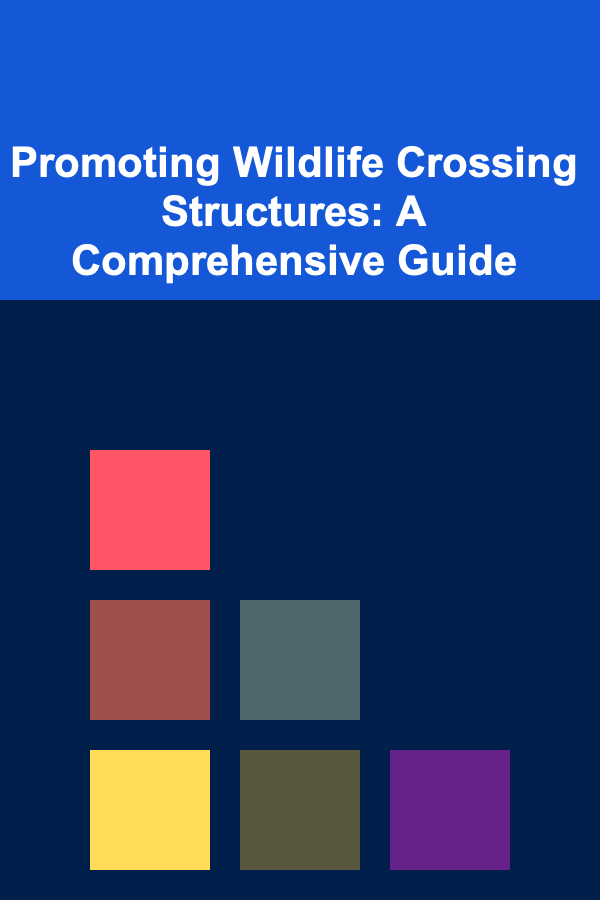
Promoting Wildlife Crossing Structures: A Comprehensive Guide
ebook include PDF & Audio bundle (Micro Guide)
$12.99$6.99
Limited Time Offer! Order within the next:

Introduction: Bridging the Divide for a Sustainable Future
Wildlife crossing structures, such as overpasses, underpasses, culverts, and green bridges, represent a crucial intersection of ecological conservation and human infrastructure development. As human populations expand and transportation networks grow denser, the fragmentation of natural habitats intensifies. Roads and railways act as significant barriers, isolating wildlife populations, disrupting migration patterns, increasing wildlife-vehicle collisions, and threatening biodiversity. The implementation of effective wildlife crossing structures, therefore, is no longer a luxury but a necessity for maintaining healthy ecosystems and ensuring the long-term viability of wildlife populations.
However, building these structures is only half the battle. Successfully promoting their adoption and widespread implementation requires a multifaceted approach that encompasses public awareness, political advocacy, scientific validation, and collaborative partnerships. This article delves into the strategies and techniques necessary to effectively promote wildlife crossing structures, aiming to foster a greater understanding of their importance and encourage their integration into infrastructure planning and development.
Understanding the Need: The Ecological and Societal Benefits
Before embarking on promotional efforts, it's vital to have a deep understanding of the benefits that wildlife crossing structures offer. These benefits can be broadly categorized into ecological and societal advantages.
Ecological Benefits: Connecting Landscapes, Conserving Biodiversity
- Reducing Habitat Fragmentation: Roads and railways create physical barriers, dividing habitats and isolating populations. Crossing structures reconnect these fragmented landscapes, allowing wildlife to move freely and access vital resources such as food, water, and mates. This reconnection helps maintain genetic diversity and reduces the risk of local extinctions.
- Facilitating Migration and Dispersal: Many species rely on seasonal migrations or dispersal to new territories for survival and reproduction. Crossing structures provide safe passage across transportation corridors, enabling these essential movements and supporting healthy population dynamics.
- Conserving Biodiversity: By reducing habitat fragmentation and facilitating movement, crossing structures help maintain biodiversity at both the species and ecosystem levels. They allow a greater variety of species to thrive in areas impacted by human infrastructure.
- Protecting Vulnerable Species: Specific species, such as large mammals, amphibians, and reptiles, are particularly vulnerable to road mortality. Crossing structures can provide targeted solutions to protect these species and prevent population declines.
Societal Benefits: Safety, Savings, and Enhanced Ecosystem Services
- Reducing Wildlife-Vehicle Collisions: Wildlife-vehicle collisions (WVCs) pose a significant threat to human safety and result in substantial economic costs. Crossing structures significantly reduce the frequency of WVCs, minimizing the risk of injuries, fatalities, and vehicle damage.
- Economic Savings: The economic costs associated with WVCs are considerable, including vehicle repairs, medical expenses, and lost productivity. While crossing structures involve upfront investment, the long-term savings from reduced WVCs can often outweigh the initial costs. Furthermore, preventing animal deaths can save resources and time spent on road cleanup and animal removal.
- Enhanced Ecosystem Services: Healthy ecosystems provide a range of essential services, such as clean water, pollination, and carbon sequestration. By supporting biodiversity and ecological connectivity, crossing structures contribute to the provision of these ecosystem services, benefiting human society.
- Improved Public Perception: Investing in wildlife crossing structures demonstrates a commitment to environmental stewardship and enhances the public image of transportation agencies and developers. This can lead to increased public support for future projects and initiatives.
Targeting Your Audience: Identifying Key Stakeholders
Effective promotion requires understanding your audience and tailoring your message to resonate with their specific concerns and interests. Key stakeholders to consider include:
- General Public: Raising public awareness is crucial for building support for wildlife crossing structures. The general public can influence political decisions and support funding initiatives.
- Transportation Agencies: State Departments of Transportation (DOTs) and other transportation agencies are responsible for planning, designing, and constructing infrastructure projects. Convincing them of the value of crossing structures is essential for their widespread implementation.
- Elected Officials: Policymakers at the local, state, and federal levels have the power to enact legislation and allocate funding for wildlife crossing projects. Educating them about the benefits of these structures is critical for securing their support.
- Conservation Organizations: Environmental groups and conservation organizations are important allies in promoting wildlife crossing structures. They can provide scientific expertise, advocacy support, and public outreach.
- Land Developers: Private developers play a significant role in land use planning and construction. Encouraging them to incorporate wildlife crossing structures into their projects can help mitigate the impacts of development on wildlife.
- Academic Researchers: Scientists and researchers can provide valuable data on the effectiveness of crossing structures and contribute to the development of best practices. Their research can inform policy decisions and guide implementation efforts.
- Insurance Companies: Insurance companies bear the financial burden of wildlife-vehicle collisions. They may be interested in supporting the implementation of crossing structures as a way to reduce their costs.
- Local Communities: Communities affected by road construction or wildlife movements need to be involved in the planning and decision-making process. Addressing their concerns and incorporating their input can help build support for crossing structures.
Crafting Your Message: Emphasizing the Benefits for Each Audience
Once you've identified your target audience, you need to craft messages that resonate with their specific concerns and priorities. Here are some examples of how to tailor your message for different stakeholders:
- For the General Public: Focus on the safety aspects of crossing structures, highlighting how they reduce wildlife-vehicle collisions and protect human lives. Use compelling visuals, such as photos and videos of wildlife using crossing structures, to illustrate the positive impact of these structures. Emphasize the importance of biodiversity and the need to protect wildlife for future generations. Appeal to their sense of responsibility towards the environment and highlight the aesthetic value of seeing wildlife thriving in their area.
- For Transportation Agencies: Emphasize the cost-effectiveness of crossing structures, highlighting the long-term savings from reduced wildlife-vehicle collisions. Present data on the effectiveness of different types of crossing structures and provide guidance on best practices for design and implementation. Showcase successful examples of crossing structures that have been implemented in other regions. Address concerns regarding construction costs and maintenance requirements. Highlight how implementing crossing structures aligns with sustainability goals and improves the agency's public image.
- For Elected Officials: Frame crossing structures as a smart investment that benefits both the environment and the economy. Emphasize the public safety benefits of reducing wildlife-vehicle collisions and the potential for job creation in the construction and maintenance of these structures. Present data on the economic impact of WVCs in their constituency and demonstrate how crossing structures can address this problem. Highlight the positive impact on tourism and recreation.
- For Conservation Organizations: Emphasize the ecological benefits of crossing structures, highlighting their role in reducing habitat fragmentation, conserving biodiversity, and protecting vulnerable species. Provide scientific expertise and advocacy support to promote the implementation of these structures. Collaborate on research projects to monitor the effectiveness of crossing structures and inform best practices. Use their established communication channels to reach a wider audience.
- For Land Developers: Highlight the potential for crossing structures to enhance the value of their properties by creating more attractive and sustainable communities. Provide guidance on how to incorporate crossing structures into their projects in a cost-effective manner. Showcase examples of developments that have successfully integrated wildlife crossings. Emphasize the benefits for marketing and public relations.
- For Insurance Companies: Present data on the financial losses associated with wildlife-vehicle collisions and demonstrate how crossing structures can reduce these losses. Explore opportunities for partnerships to support the implementation of crossing structures.
- For Local Communities: Engage the community early in the planning process and address their concerns about potential impacts on traffic, noise, and aesthetics. Highlight the benefits of crossing structures for local wildlife populations and the overall quality of life in the community. Provide opportunities for community members to participate in monitoring and stewardship activities.
Choosing Your Channels: Reaching Your Audience Effectively
The effectiveness of your promotional efforts depends on choosing the right channels to reach your target audience. Here are some key communication channels to consider:
- Public Awareness Campaigns: Utilize various media channels, such as television, radio, print, and online advertising, to raise awareness about the importance of wildlife crossing structures. Develop engaging and informative content, such as videos, infographics, and social media posts, to reach a wider audience.
- Educational Programs: Develop educational programs for schools, community groups, and other organizations to teach people about the importance of wildlife crossing structures and the role they play in conserving biodiversity.
- Website and Social Media: Create a website and social media presence to share information about wildlife crossing structures, showcase successful examples, and provide updates on current projects. Use social media to engage with your audience, answer questions, and promote events.
- Public Meetings and Presentations: Organize public meetings and presentations to inform community members about proposed crossing structure projects and gather their feedback. Present information in a clear and accessible manner, using visuals and real-world examples.
- Media Relations: Develop relationships with journalists and media outlets to generate positive coverage of wildlife crossing structures. Provide them with press releases, background information, and expert interviews.
- Conferences and Workshops: Attend conferences and workshops related to transportation, wildlife conservation, and infrastructure development to share information about wildlife crossing structures and network with other professionals in the field.
- Scientific Publications: Publish research findings in peer-reviewed journals to demonstrate the effectiveness of wildlife crossing structures and inform best practices.
- Policy Briefs and Reports: Develop policy briefs and reports to provide policymakers with concise and evidence-based information about the benefits of wildlife crossing structures.
- Partnerships and Collaborations: Collaborate with other organizations, such as conservation groups, transportation agencies, and academic institutions, to amplify your message and reach a wider audience.
- Citizen Science Initiatives: Involve the public in monitoring the effectiveness of wildlife crossing structures through citizen science initiatives. This can help build support for these structures and provide valuable data for researchers.
Demonstrating Success: Showcasing Evidence and Monitoring Effectiveness
Demonstrating the effectiveness of wildlife crossing structures is crucial for building support and securing funding for future projects. This involves collecting and analyzing data on wildlife use of crossing structures, as well as monitoring the impact on wildlife-vehicle collisions and population dynamics.
- Wildlife Monitoring: Use various techniques, such as camera traps, track surveys, and DNA analysis, to monitor wildlife use of crossing structures. Collect data on the number of animals using the structures, the species that are using them, and their behavior.
- Collision Data Analysis: Track wildlife-vehicle collision data before and after the implementation of crossing structures to assess their impact on reducing collisions. Use statistical analysis to determine the effectiveness of the structures in preventing collisions.
- Population Studies: Conduct population studies to assess the impact of crossing structures on wildlife populations. Monitor population size, genetic diversity, and movement patterns to determine whether crossing structures are helping to maintain healthy populations.
- Reporting and Dissemination: Share your findings with stakeholders through reports, presentations, publications, and online platforms. Use data visualization techniques to present your findings in a clear and compelling manner.
- Adaptive Management: Use monitoring data to inform adaptive management strategies, adjusting the design and management of crossing structures to improve their effectiveness.
Overcoming Challenges: Addressing Common Concerns and Misconceptions
Promoting wildlife crossing structures often involves addressing common concerns and misconceptions. Here are some of the most frequent challenges and how to overcome them:
- High Costs: Address the perception that crossing structures are too expensive by highlighting the long-term savings from reduced wildlife-vehicle collisions. Explore cost-effective design and construction techniques. Seek funding from multiple sources, including federal grants, state funding, and private donations. Emphasize that the cost of not building them (in terms of WVCs, loss of biodiversity, and ecological damage) is often higher in the long run.
- Lack of Evidence: Provide scientific evidence demonstrating the effectiveness of crossing structures in reducing wildlife-vehicle collisions and conserving biodiversity. Share data from successful projects around the world. Support ongoing research to further improve our understanding of how these structures work.
- Aesthetic Concerns: Address aesthetic concerns by designing crossing structures that are visually appealing and blend in with the surrounding landscape. Incorporate green infrastructure, such as native plants, into the design. Engage with local communities to address their concerns about the visual impact of the structures.
- Maintenance Requirements: Explain the maintenance requirements of crossing structures and develop a plan for ensuring that they are properly maintained over time. Explore innovative maintenance techniques that minimize costs and environmental impacts.
- Perception of "Animal Rights" vs. Human Needs: Frame the issue as one that benefits both humans and wildlife. Stress the safety and economic benefits for people, as well as the ecological advantages for animals. Show how crossing structures can contribute to a more sustainable and harmonious relationship between humans and nature.
- Bureaucratic Hurdles: Navigating complex permitting processes and regulatory requirements can be challenging. Work with regulatory agencies to streamline the permitting process and ensure that crossing structure projects are prioritized. Build strong relationships with relevant government officials and advocate for policies that support the implementation of these structures.
The Future of Wildlife Crossings: Innovation and Collaboration
The field of wildlife crossing structure design and implementation is constantly evolving. Future advancements will likely focus on:
- Innovative Designs: Developing more cost-effective and adaptable crossing structure designs that can be tailored to specific species and landscapes. This includes exploring new materials, construction techniques, and monitoring technologies.
- Landscape-Scale Planning: Integrating wildlife crossing structures into comprehensive landscape-scale planning efforts that consider the needs of wildlife populations across entire regions. This requires collaboration between transportation agencies, conservation organizations, and land developers.
- Smart Technology: Using smart technology, such as sensors and artificial intelligence, to monitor wildlife movements, optimize crossing structure placement, and adaptively manage crossing structure design.
- Enhanced Collaboration: Fostering greater collaboration between transportation agencies, conservation organizations, academic institutions, and private landowners to promote the widespread implementation of wildlife crossing structures.
- Policy and Funding: Advocating for policies and funding mechanisms that support the implementation of wildlife crossing structures at the local, state, and federal levels. This includes developing incentive programs, streamlining permitting processes, and increasing funding for research and implementation.
Conclusion: Building a Future Where Wildlife and Humans Can Thrive
Promoting wildlife crossing structures is not merely about building physical structures; it's about building a future where wildlife and humans can coexist and thrive. By raising awareness, advocating for policies, showcasing evidence, and fostering collaboration, we can create a world where transportation infrastructure and natural ecosystems are seamlessly integrated. The effort requires a sustained and concerted effort from all stakeholders, working together to ensure the long-term viability of wildlife populations and the health of our planet. By embracing the principles outlined in this guide, we can pave the way for a future where roads are no longer barriers, but rather bridges connecting habitats and ensuring a sustainable future for all.

How to Create a Budget-Friendly Meal Plan for the Week
Read More
How to Create a Comprehensive Personal Budget That Works for You
Read More
The Insurance Underwriter's Guide: Mastering Risk Assessment and Policy Evaluation
Read More
Top Tips for Saving on Taxes and Maximizing Your Refund
Read More
How to Cultivate Empathy and Understanding
Read More
10 Tips for Planning a Collaborative Writing Project
Read MoreOther Products

How to Create a Budget-Friendly Meal Plan for the Week
Read More
How to Create a Comprehensive Personal Budget That Works for You
Read More
The Insurance Underwriter's Guide: Mastering Risk Assessment and Policy Evaluation
Read More
Top Tips for Saving on Taxes and Maximizing Your Refund
Read More
How to Cultivate Empathy and Understanding
Read More